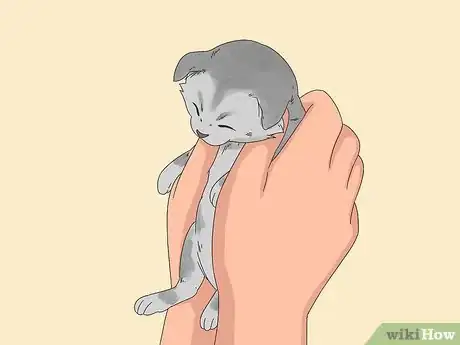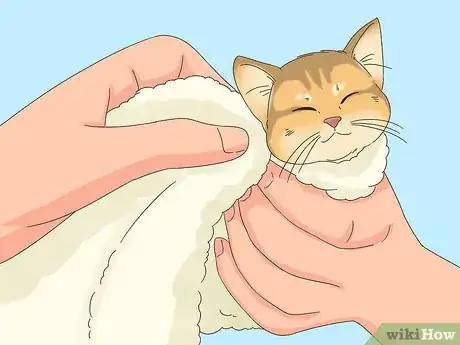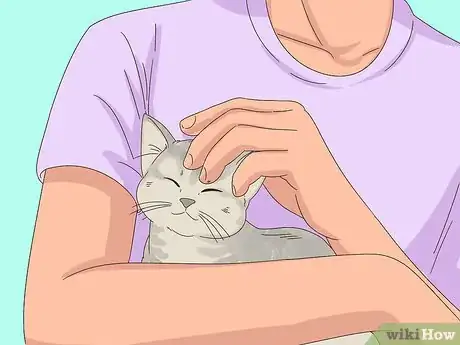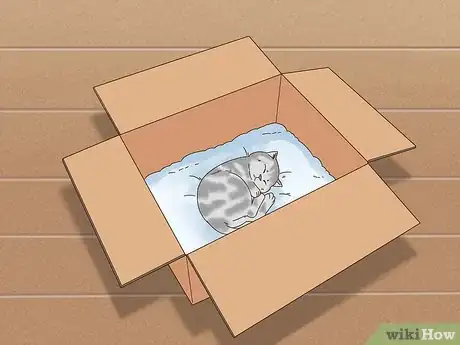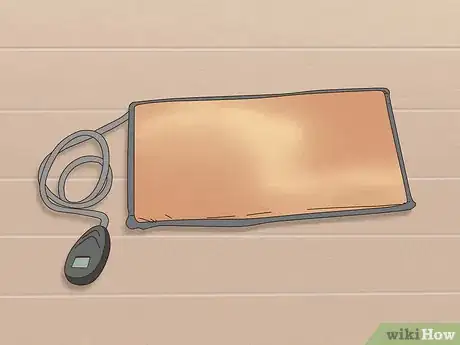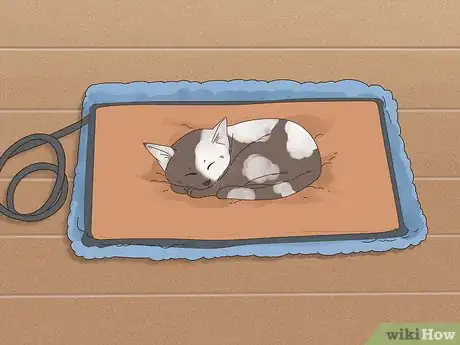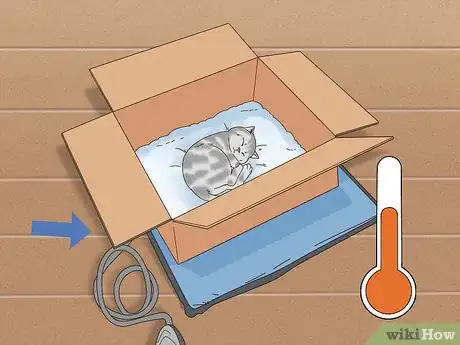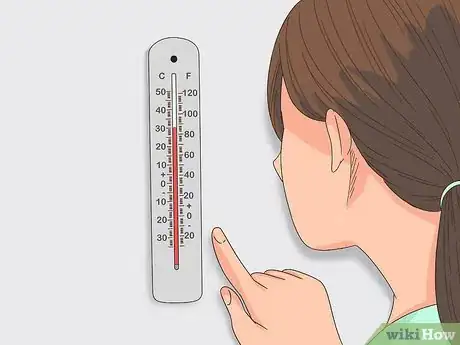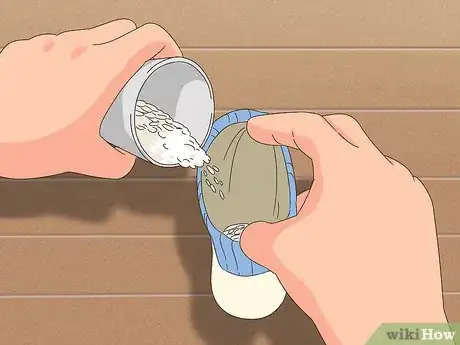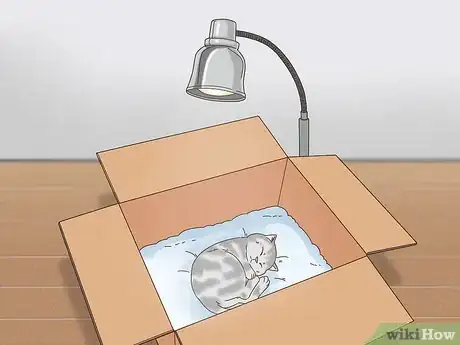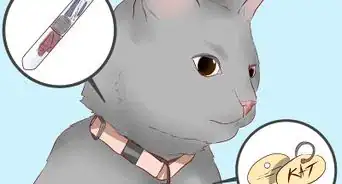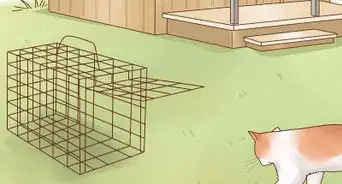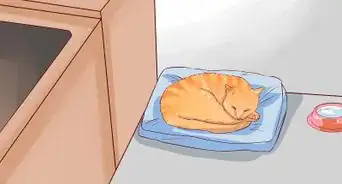This article was co-authored by Deanne Pawlisch, CVT, MA. Deanne Pawlisch is a Certified Veterinary Technician, who does corporate training for veterinary practices and has taught at the NAVTA-approved Veterinary Assistant Program at the Harper College in Illinois and in 2011 was elected to the board of the Veterinary Emergency and Critical Care Foundation. Deanne has been a Board Member of the Veterinary Emergency and Critical Care Foundation in San Antonio, Texas since 2011. She holds a BS in Anthropology from Loyola University and an MA in Anthropology from Northern Illinois University.
There are 10 references cited in this article, which can be found at the bottom of the page.
wikiHow marks an article as reader-approved once it receives enough positive feedback. In this case, 94% of readers who voted found the article helpful, earning it our reader-approved status.
This article has been viewed 59,718 times.
Keeping young kittens warm is essential, as hypothermia is the most significant threat to their health. If you’ve rescued an orphaned litter, make sure they’re dry and check if they’re chilled. Hold any chilled kittens to your bare skin to gradually warm them, and avoid feeding a chilled kitten. Create a nest by lining a cardboard box with towels or a blanket and keep the nest warm. Consider using a snuggle disk or, with caution, a normal heating pad, a bottle of hot water, or a heated sock filled with uncooked rice. Monitor the nest’s ambient temperature, and keep the kittens warmly nestled for four weeks.
Steps
Warming Chilled Kittens
-
1Determine the kittens’ age. Knowing how old the kittens are will give you a better idea of the type of care they’ll need and how long you’ll have to keep them in a nest. As a rule, kittens gain about one pound per month. Use these other guidelines to determine the kittens’ age:[1]
- Kittens less than two weeks old will have closed eyes and folded down ears, while kittens between two and three weeks old will have open eyes and wobble or crawl.
- Kittens between three and four weeks will have open eyes, erect ears, and can walk.
- Kittens older than four weeks can run and most likely won’t require nesting.
- The average kitten weighs 3.5 ounces (99 grams) at birth, and will gain about 1 pound (.5 kilograms) every month.[2]
-
2Dry the kittens if they’re wet. If you’ve found a litter of wet orphaned kittens, thoroughly dry them with a towel as soon as possible. If the kittens are wet, they’re at a greater risk of developing hypothermia.[3]
- If the kittens are at least a week old, you can use a blow dryer on a low setting to dry them. Make sure the air stream isn’t hot and avoid blowing the kitten’s face. It’s not recommended to use a blow dryer on kittens less than one week old.
Advertisement -
3Check if the kittens are chilled. Touch the kittens’ ears, inside their mouths, and the pads of their feet. If any of these feel cool to the touch, that kitten’s body temperature is too low.[4]
- If you have a baby or small pet rectal thermometer, you can also take the kittens’ temperatures. Newborn kittens should have a body temperature at 1 week of 95-99 degrees Fahrenheit (35-37.2 degrees Celsius), 97-100 degrees Fahrenheit (36.1-37.7 degrees Celsius) at 2 to 3 weeks, and 99-101 degrees Fahrenheit (37.2-38.3 degrees Celsius) from 3 weeks on.[5]
-
4Hold a chilled kitten against your bare skin to warm it gradually. If a kitten is chilled, you’ll need to warm it promptly but gradually. Hold it against your bare skin and periodically rub it with your hands to raise its temperature slowly.[6]
- If possible, have someone put a towel in the dryer on low heat for 10 minutes while you hold the kitten. Once the towel is warm, wrap the kitten with it.
- Avoid submerging the kitten in hot water or taking any other measures to warm it too quickly.
-
5Avoid feeding a kitten until it’s warm. It’s essential to only feed a kitten once you’ve increased its body temperature. Feeding a kitten with a temperature less than 90 degrees Fahrenheit (32.2 degrees Celsius) can be life-threatening.[7]
- A kitten can’t digest food if it’s chilled. Do not attempt to feed the animal with a syringe, as it may not be able to swallow and could inhale the food and die. Try to get medical care for the kitten, instead.
Using a Heating Pad to Warm the Nest
-
1Create a nest by lining a cardboard box with towels or a blanket. Line the bottom of a high-sided cardboard box with clean, dry towels or a blanket. Keep the box away from drafts, air conditioning vents, or other sources of cool air.[8]
- Cardboard is an insulator, so it makes a great kitten nest.
- Change the bedding at least daily to maintain a clean environment.
-
2Purchase a heating pad. Snuggle disks are the most effective heating pads, as they are specifically made for small pets like cats. You can purchase a snuggle disk at your local pet supply store. If you unable to purchase a snuggle disk, use a normal heating pad.[9]
- Snuggle Safe is a good snuggle disk brand.
-
3Keep the heating pad at an appropriate temperature and wrap it well. It’s important to ensure the heating pad won’t burn the kittens. If you are using snuggle disk, follow the instructions on the box--these are typically microwaveable. If you are using a normal heating pad, keep it on a low setting. For both types of heating pads, wrap them securely with a thick towel to make sure the kittens can’t access the pad itself.
- Check the pad and its wrapping regularly to make sure it’s not too hot.
-
4Heat one side of the box with a heating pad. Place half of the box onto a heating pad. You can also place the heating pad in the box beneath the bedding. Your goal is to create a heated zone in half of the box and a cooler zone in the other half.[10]
- The kittens will move from one side of the box to the other to warm or cool themselves.
-
5Monitor the nest’s ambient temperature. You should routinely check the nest’s temperature using an air thermometer. The ideal ambient temperature for kittens up to two weeks old is around 85 degrees Fahrenheit (approximately 30 degrees Celsius). Ambient nest temperature for three and four week old kittens should be between 75 and 80 degrees Fahrenheit (24 to 27 degrees Celsius).[11]
- Keep the kittens in the nest and routinely monitor the ambient temperature for four to five weeks.[12]
Trying Other Warming Methods
-
1Fill a bottle with hot water and wrap it in a towel. If you don’t have a heating pad, you can use a bottle of hot water to keep the nest warm. Fill a bottle with water heated to around 100 degrees Fahrenheit (around 38 degrees Celsius). Wrap it securely in a towel, and place it in the nest’s bedding.[13]
- You’ll have to check the temperature frequently and replace the water bottle at least every two hours.
-
2Try heating a sock filled with uncooked rice or beans. Placing a hot sock in the nest is an alternative way to warm the kittens. Fill an old sock with uncooked rice or white beans, then tie the open end into a knot. Microwave the sock for 60 seconds, then place it in the nest.[14]
- Like the water bottle method, you’ll have to check the temperature frequently and reheat the sock at least every two hours.
-
3Place a heat lamp over the nest. Some vets and kitten fosters prefer using a heat lamp instead of an electric heating pad. If you opt for a heat lamp, hang it over the nesting box and position it towards one side of the box.[15]
- Make sure the heat lamp is out of the kittens’ reach, especially as they get older and become more mobile.
- Be very careful when using a heat lamp with cardboard– it is a fire risk. Avoid direct contact between the heat lamp and the cardboard.
References
- ↑ http://www.homeatlastrescue.org/html/aboutcats/kittencare.html
- ↑ http://pets.webmd.com/cats/guide/newborn-kitten-care#2
- ↑ https://kittenrescue.org/cat-care/
- ↑ http://www.animalalliancenyc.org/wordpress/2013/05/what-to-do-and-not-do-if-you-find-a-newborn-kitten/
- ↑ http://www.merckvetmanual.com/management-and-nutrition/management-of-the-neonate/overview-of-management-of-the-neonate-in-small-animals
- ↑ http://www.homeatlastrescue.org/html/aboutcats/kittencare.html
- ↑ http://www.homeatlastrescue.org/html/aboutcats/kittencare.html
- ↑ http://www.cat-world.com.au/raising-orphaned-kittens
- ↑ http://www.sheltermedicine.com/library/guidebooks/guide-to-raising-underage-kittens/caring-for-kittens-from-birth-to-eight-weeks
- ↑ http://www.acfacat.com/Articles/health%20handbook.pdf
- ↑ http://www.cathealth.com/reproduction/how-to-care-for-orphaned-kittens
- ↑ https://kittenrescue.org/cat-care/
- ↑ https://kittenrescue.org/cat-care/
- ↑ http://www.kitten-rescue.com/cold_kitten.html
- ↑ https://kittenrescue.org/cat-care/
- ↑ http://www.animalalliancenyc.org/wordpress/2013/05/what-to-do-and-not-do-if-you-find-a-newborn-kitten/
About This Article
To keep orphaned kittens warm, start by holding them against your bare skin to raise their temperature slowly. Then, line a cardboard box with towels or a blanket to make a nest, and put a well-wrapped heating pad set on low in the bottom of the box. Alternatively, fill a bottle with hot water, wrap it in a towel, and put it in the nest. You can also fill an old sock with uncooked rice or beans, microwave it for 60 seconds, and place it in the nest to warm the kittens. For more tips from our Veterinary co-author, including how to tell if a kitten has hypothermia, keep reading!
